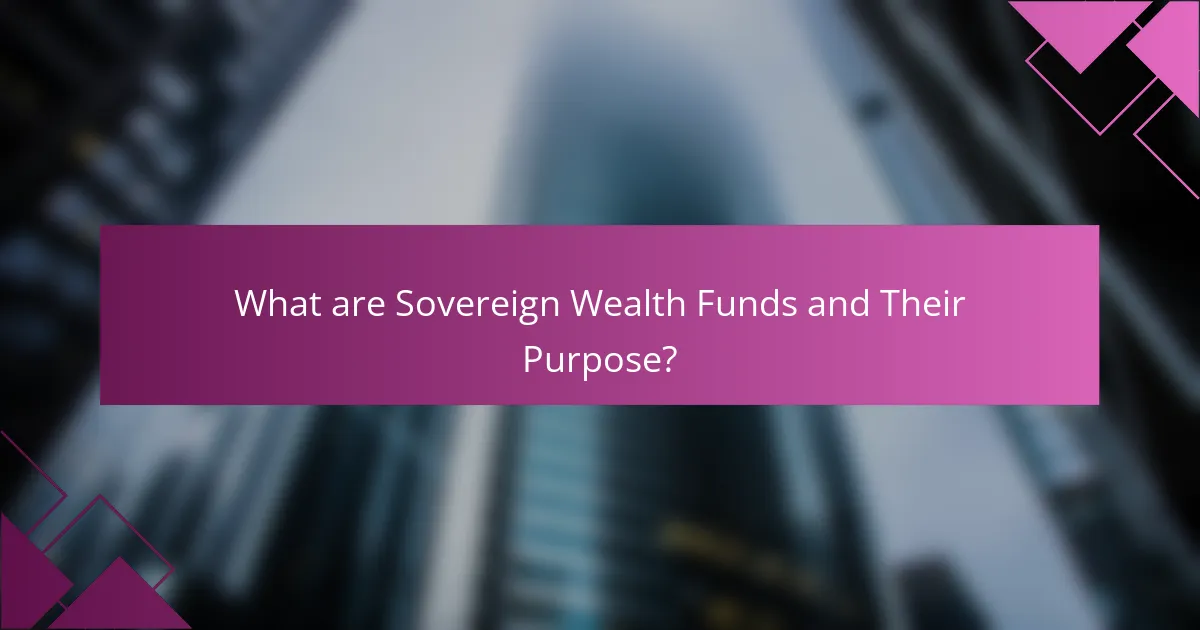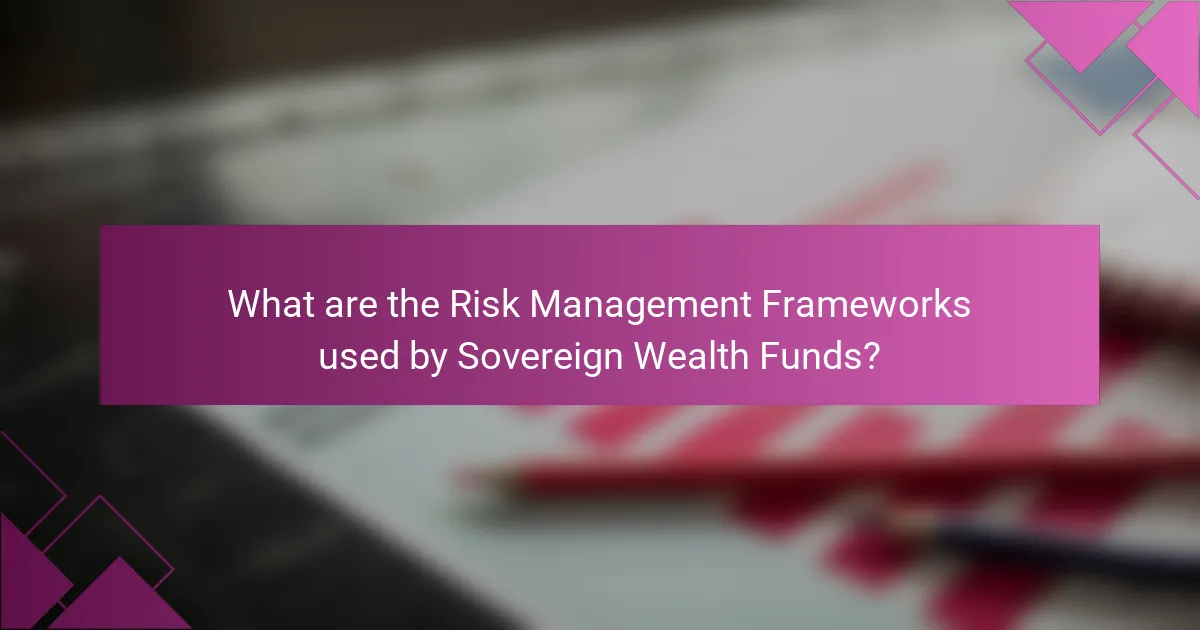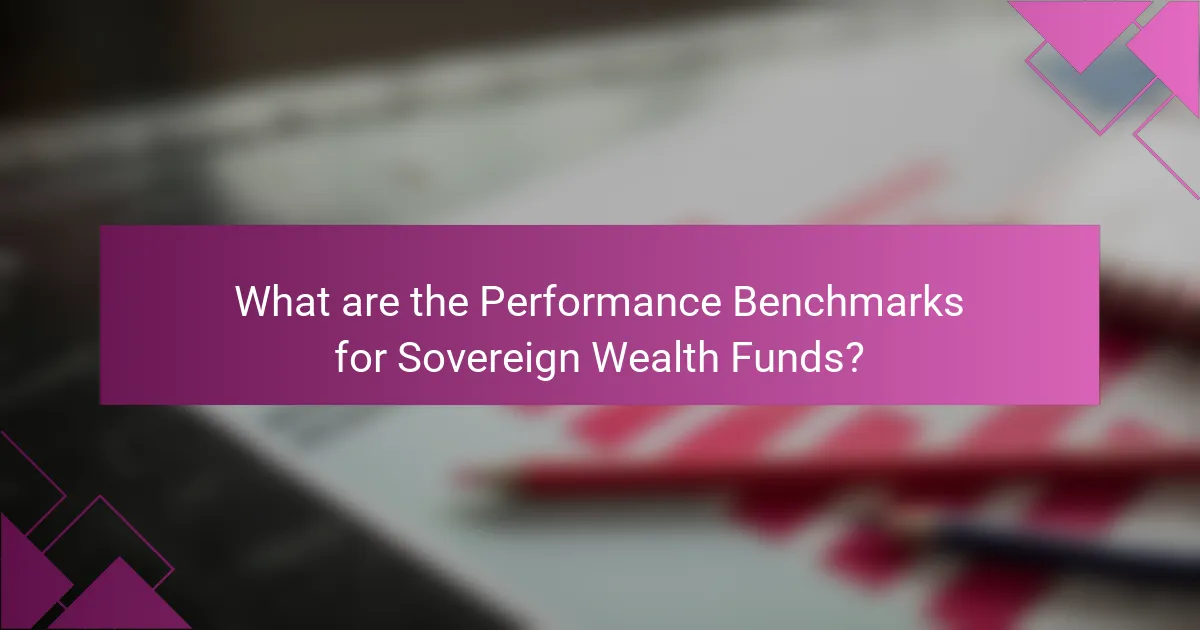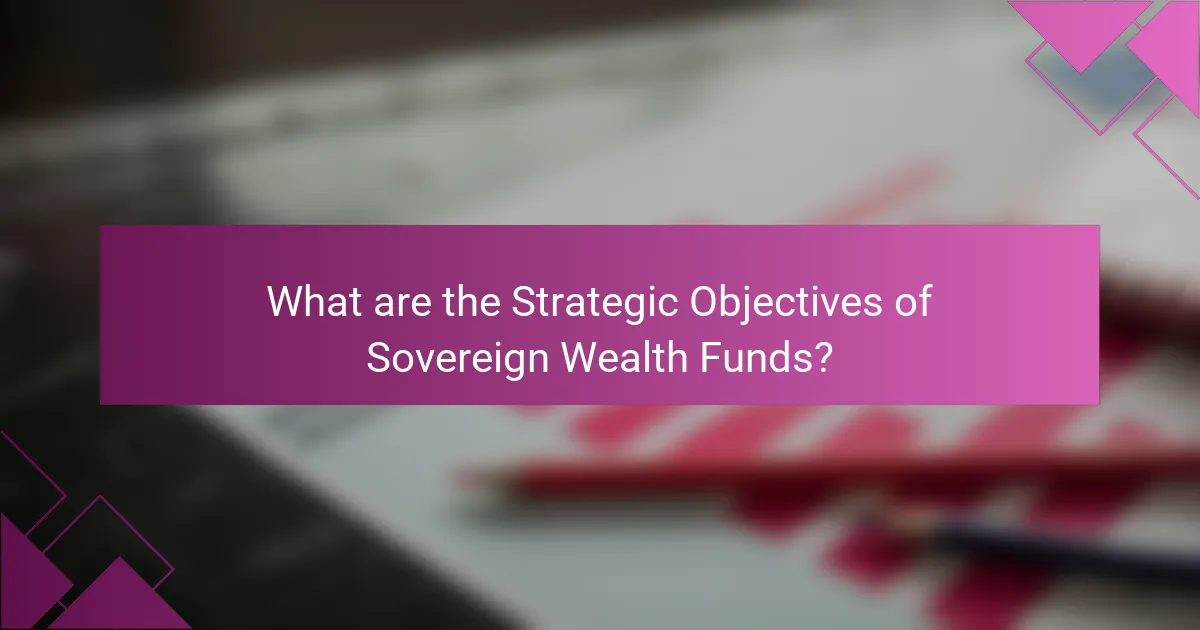
What are Sovereign Wealth Funds and their Purpose?
Sovereign Wealth Funds (SWFs) are state-owned investment funds or entities. Their primary purpose is to manage a country’s reserves for various economic benefits. SWFs invest in a diverse range of assets, including stocks, bonds, real estate, and infrastructure. They aim to stabilize the economy, save for future generations, and fund social or economic projects. For example, the Government Pension Fund of Norway is one of the largest SWFs, designed to invest the country’s oil revenues. SWFs also play a role in enhancing national wealth and reducing dependence on volatile revenue sources. According to the International Monetary Fund, as of 2021, there are over 90 SWFs globally, managing assets exceeding $9 trillion.
How do Sovereign Wealth Funds differ from other investment funds?
Sovereign Wealth Funds (SWFs) differ from other investment funds primarily in their ownership and purpose. SWFs are state-owned investment funds that manage national savings for various objectives, such as economic stabilization or future generations’ wealth. In contrast, other investment funds, like mutual funds or hedge funds, are typically owned by private investors or institutions and focus on maximizing returns for their shareholders.
SWFs often invest in a broader range of assets, including foreign stocks, bonds, and real estate, while other funds may have more restrictive investment mandates. The governance structure of SWFs is influenced by national policies and regulations, whereas private funds operate under market-driven principles. Additionally, SWFs tend to have a longer investment horizon, aiming for sustainable growth rather than short-term profits.
For example, according to the International Monetary Fund, SWFs manage over $9 trillion in assets globally, reflecting their significant role in the financial markets. This substantial capital allows them to influence global investment trends and stabilize their respective economies.
What are the primary characteristics of Sovereign Wealth Funds?
Sovereign Wealth Funds (SWFs) are state-owned investment funds. They are established to manage national savings for the purpose of investment. SWFs typically invest in a variety of assets, including stocks, bonds, real estate, and commodities. These funds are often funded by surplus revenues from natural resources, such as oil and gas. SWFs aim to achieve long-term financial returns while stabilizing the economy. They also play a role in diversifying a country’s income sources. Transparency and governance are key characteristics of effective SWFs. Many countries have established regulations to ensure accountability and ethical management of these funds.
Why do countries establish Sovereign Wealth Funds?
Countries establish Sovereign Wealth Funds (SWFs) to manage national savings and stabilize their economies. SWFs provide a means to invest surplus revenues, particularly from natural resources, into diversified assets. This helps to mitigate the effects of volatile commodity prices. For example, Norway’s Government Pension Fund Global invests oil revenues to secure future generations’ wealth. Additionally, SWFs can support economic development and infrastructure projects. Countries like Singapore utilize their SWFs to foster long-term economic growth and stability. These funds also serve as buffers during financial crises, ensuring liquidity and fiscal resilience. Overall, SWFs are strategic tools for wealth management and economic stabilization.
What are the key components of a Sovereign Wealth Fund?
The key components of a Sovereign Wealth Fund include governance structure, investment strategy, funding sources, and performance measurement.
Governance structure defines how the fund is managed and overseen. It typically involves a board of directors or trustees responsible for decision-making. Investment strategy outlines the asset allocation and approach to risk management. This strategy guides how the fund invests in various asset classes.
Funding sources refer to the origins of the capital, which may include surplus revenues from natural resources or fiscal surpluses. Performance measurement assesses the fund’s returns against benchmarks to evaluate success.
These components are essential for the effective operation and sustainability of a Sovereign Wealth Fund.
What types of assets do Sovereign Wealth Funds typically hold?
Sovereign Wealth Funds typically hold a diverse range of assets. These assets include equities, fixed income securities, real estate, and alternative investments. Equities represent ownership in companies and can provide capital appreciation. Fixed income securities, such as government and corporate bonds, offer stable returns. Real estate investments provide both income and potential value appreciation. Alternative investments may include private equity, hedge funds, and commodities. According to the Sovereign Wealth Fund Institute, as of 2021, over 50% of the assets in these funds are allocated to equities and fixed income. This diversified approach helps mitigate risk and achieve long-term financial goals.
How do governance structures impact the effectiveness of Sovereign Wealth Funds?
Governance structures significantly impact the effectiveness of Sovereign Wealth Funds (SWFs). Effective governance ensures transparency and accountability in decision-making processes. Strong governance frameworks lead to better investment strategies and risk management practices. For instance, the Santiago Principles provide guidelines that enhance governance and operational practices among SWFs. Countries with robust governance structures, such as Norway and Singapore, demonstrate higher performance and stability in their SWFs. These nations implement clear rules and oversight mechanisms, which contribute to long-term investment success. In contrast, SWFs with weak governance often face challenges like mismanagement and lack of strategic focus, leading to suboptimal performance.

What are the Risk Management Frameworks used by Sovereign Wealth Funds?
Sovereign Wealth Funds (SWFs) utilize various risk management frameworks to mitigate financial risks. Common frameworks include the Enterprise Risk Management (ERM) framework, which addresses risks across all areas of the fund. SWFs also adopt a Value-at-Risk (VaR) model to quantify potential losses in investment portfolios. Additionally, stress testing is employed to assess how extreme market conditions could impact fund performance.
SWFs often implement diversification strategies to reduce exposure to specific asset classes. Regulatory compliance frameworks ensure adherence to international standards and best practices. Moreover, continuous monitoring and reporting processes are integral to maintaining risk oversight. These frameworks collectively help SWFs achieve their strategic objectives while managing potential risks effectively.
How is risk assessed within Sovereign Wealth Funds?
Risk is assessed within Sovereign Wealth Funds (SWFs) through a combination of quantitative and qualitative methods. These methods include risk modeling, scenario analysis, and stress testing. SWFs analyze market risk, credit risk, and liquidity risk to understand potential impacts on their portfolios. They often utilize Value at Risk (VaR) calculations to measure potential losses. Additionally, they assess geopolitical and regulatory risks that could affect their investments. SWFs also conduct regular reviews of their investment strategies and asset allocations. This comprehensive approach ensures that they can adapt to changing market conditions. For example, the Government Pension Fund of Norway employs a robust risk management framework that includes extensive reporting and transparency measures.
What methodologies are commonly employed for risk assessment?
Common methodologies employed for risk assessment include qualitative and quantitative approaches. Qualitative methods involve expert judgment and subjective evaluations. Techniques such as interviews and focus groups are often utilized. Quantitative methods rely on statistical analysis and mathematical models. Common tools include Value at Risk (VaR) and Monte Carlo simulations. These methodologies help in identifying, analyzing, and prioritizing risks. They are essential for effective decision-making in risk management. Research indicates that a combination of both methodologies often yields the best results. This hybrid approach enhances the robustness of risk assessments.
How do Sovereign Wealth Funds mitigate investment risks?
Sovereign Wealth Funds mitigate investment risks through diversification and strategic asset allocation. They invest across various asset classes, including equities, bonds, real estate, and alternative investments. This broad investment approach reduces the impact of poor performance in any single asset class. Additionally, they often hold investments in different geographical regions to further spread risk.
Sovereign Wealth Funds also employ rigorous risk assessment frameworks. They analyze market trends, economic indicators, and geopolitical factors to inform their investment decisions. Many funds utilize sophisticated models to predict potential risks and returns. Furthermore, they maintain liquidity profiles to ensure they can meet obligations during market downturns.
The Norwegian Government Pension Fund Global is a prime example. It diversifies its portfolio across over 9,000 companies globally. This strategy has helped it maintain stability and achieve long-term growth despite market fluctuations.
What role does diversification play in risk management?
Diversification plays a crucial role in risk management by spreading investments across various assets. This strategy reduces the impact of poor performance in any single investment. By holding a mix of asset classes, such as stocks, bonds, and real estate, investors can mitigate potential losses. Historical data shows that diversified portfolios tend to perform more consistently over time. For instance, a study by Markowitz in 1952 established the benefits of diversification in optimizing portfolio returns while minimizing risk. Therefore, effective diversification is essential for managing risk in investment strategies, particularly for sovereign wealth funds.
How do Sovereign Wealth Funds achieve diversification across asset classes?
Sovereign Wealth Funds achieve diversification across asset classes by strategically allocating investments across various sectors and geographies. They invest in equities, fixed income, real estate, commodities, and alternative assets. This broad allocation helps mitigate risks associated with market volatility. For instance, during economic downturns, certain asset classes may perform better than others. By holding a mix of assets, these funds can reduce overall portfolio risk. Historical data shows that diversified portfolios tend to have more stable returns over time. Additionally, Sovereign Wealth Funds often employ professional managers to optimize asset allocation based on market conditions. This active management further enhances their ability to achieve diversification.
What are the risks associated with concentration in specific investments?
Concentration in specific investments poses significant risks, including increased volatility and reduced diversification. When an investor allocates a large portion of funds to a single investment, they become highly exposed to that asset’s performance. This can lead to substantial losses if the investment underperforms. For example, during the 2008 financial crisis, concentrated portfolios suffered greater declines compared to diversified ones. Additionally, reliance on a few investments can result in liquidity risks, especially if those assets are not easily tradable. Concentrated positions may also lead to a lack of responsiveness to market changes, as investors may be less likely to adjust their holdings. Ultimately, concentration increases the likelihood of severe financial impact from adverse market events.

What are the Performance Benchmarks for Sovereign Wealth Funds?
Performance benchmarks for sovereign wealth funds typically include a combination of absolute return targets and relative performance indicators. These benchmarks often reflect the fund’s investment objectives and risk tolerance. Common benchmarks include indices such as the MSCI World Index or the Bloomberg Barclays Global Aggregate Bond Index.
Sovereign wealth funds may also use a customized benchmark that aligns with their specific asset allocation strategy. The performance is often measured over a long-term horizon, typically 5 to 10 years. For instance, the Norwegian Government Pension Fund Global aims for a return that exceeds the return of the benchmark index by 1 percent annually over time.
Additionally, many funds assess their performance against peers through comparative analysis. This approach helps to evaluate the fund’s effectiveness in achieving its investment goals relative to other sovereign funds. Data from the Sovereign Wealth Fund Institute indicates that these benchmarks play a crucial role in guiding investment decisions and ensuring accountability.
How are performance benchmarks established for Sovereign Wealth Funds?
Performance benchmarks for Sovereign Wealth Funds (SWFs) are established through a combination of strategic objectives, risk tolerance, and market comparisons. SWFs typically define their investment goals, which may include capital preservation, income generation, or growth. These objectives guide the selection of appropriate benchmarks.
Benchmarks often reflect relevant market indices or peer performance metrics. For instance, an SWF focused on equity investments may use a stock market index as its benchmark. Additionally, SWFs consider their asset allocation strategies when establishing benchmarks.
The benchmarks are regularly reviewed and adjusted to align with changing market conditions and investment strategies. This ensures that the benchmarks remain relevant and effective in measuring performance.
According to the International Forum of Sovereign Wealth Funds, best practices in benchmark selection include transparency and accountability. These practices enhance the credibility of performance measurement for SWFs.
What metrics are used to evaluate the performance of Sovereign Wealth Funds?
Sovereign Wealth Funds (SWFs) are evaluated using several key metrics. Common metrics include return on investment (ROI), which measures the profitability of the fund. Another important metric is the Sharpe ratio, which assesses risk-adjusted returns. The Information ratio is also used, comparing excess returns to the volatility of those returns. Additionally, the Total Return metric captures overall fund performance over a specified period. Benchmark comparisons against market indices provide context for performance evaluation. These metrics help stakeholders gauge the effectiveness and efficiency of SWF management.
How do benchmarks vary across different types of Sovereign Wealth Funds?
Benchmarks for Sovereign Wealth Funds (SWFs) vary based on their investment objectives and strategies. Different types of SWFs, such as pension funds, stabilization funds, and development funds, adopt distinct benchmarks. Pension funds often use liability-driven benchmarks to ensure they meet future obligations. Stabilization funds typically benchmark against macroeconomic indicators to manage volatility. Development funds focus on social and economic impact, using benchmarks that assess developmental outcomes alongside financial returns. These variations reflect each fund’s unique goals and risk profiles. For instance, the Government Pension Fund of Norway employs a benchmark that includes global equities and fixed income, aligning with its long-term investment horizon. In contrast, the Abu Dhabi Investment Authority uses a more diversified benchmark to reflect its broader investment strategy across various asset classes.
What factors influence the performance of Sovereign Wealth Funds?
The performance of Sovereign Wealth Funds (SWFs) is influenced by several key factors. Investment strategy is a primary determinant, as it dictates asset allocation and risk tolerance. Market conditions also play a crucial role, affecting returns on investments. Governance structures impact decision-making efficiency and accountability. Regulatory frameworks can either facilitate or hinder investment opportunities. Economic stability of the fund’s home country influences capital inflow and investment capacity. Lastly, the expertise of fund managers is vital in executing strategies effectively. These factors collectively shape the overall performance of SWFs.
How do market conditions affect the returns of Sovereign Wealth Funds?
Market conditions significantly influence the returns of Sovereign Wealth Funds (SWFs). Economic factors such as interest rates, inflation, and market volatility directly affect investment performance. For instance, low-interest rates can lead to higher asset prices, benefiting SWFs holding equities. Conversely, high inflation may erode purchasing power and returns. Additionally, market downturns can lead to substantial losses for SWFs, as seen during the 2008 financial crisis when many funds reported negative returns. The diversification strategies employed by SWFs can mitigate these impacts, but they remain susceptible to global economic trends. Historical data shows that SWFs with a diversified asset allocation often perform better in volatile markets. Thus, understanding market conditions is crucial for predicting SWF returns.
What impact do geopolitical events have on fund performance?
Geopolitical events significantly impact fund performance. These events can cause market volatility, affecting asset prices and investor sentiment. For instance, conflicts or political instability often lead to capital flight from affected regions. This can decrease fund values tied to those markets. Additionally, sanctions can limit investment opportunities and reduce returns. Historical examples include the 2008 financial crisis, where geopolitical tensions influenced global markets. Research shows that funds exposed to unstable regions often underperform compared to those in stable environments. Therefore, geopolitical events are critical factors in assessing fund performance.

What are the Strategic Objectives of Sovereign Wealth Funds?
Sovereign wealth funds aim to achieve financial returns, stabilize the economy, and diversify national wealth. They are investment vehicles owned by the state, typically funded by revenues from natural resources. One strategic objective is to generate long-term financial returns for future generations. This is often pursued through investments in various asset classes, including equities, bonds, and real estate.
Another objective is to provide economic stability during periods of financial crisis. Sovereign wealth funds can serve as a buffer against economic shocks by providing liquidity. Additionally, these funds aim to diversify the country’s income sources beyond natural resource dependence. This diversification helps mitigate risks associated with volatile commodity prices.
Sovereign wealth funds also focus on promoting domestic development. Investments may be directed towards infrastructure and local businesses. This approach supports economic growth and job creation within the country. Overall, the strategic objectives of sovereign wealth funds are crucial for ensuring sustainable economic growth and stability.
What are the primary goals of Sovereign Wealth Funds?
The primary goals of Sovereign Wealth Funds (SWFs) are to achieve long-term financial returns, stabilize national economies, and diversify national revenue sources. SWFs invest in various asset classes to generate returns that can support government budgets. For example, the Government Pension Fund of Norway aims to secure wealth for future generations. Stabilization funds help mitigate the impact of economic fluctuations. This is crucial for countries reliant on volatile commodities. Additionally, SWFs often seek to promote domestic economic development. By investing in local projects, they can stimulate job creation and infrastructure growth. Overall, these goals reflect a strategic approach to managing national wealth and ensuring economic stability.
How do Sovereign Wealth Funds align their strategies with national interests?
Sovereign Wealth Funds (SWFs) align their strategies with national interests by investing in sectors that promote economic stability and growth. They prioritize investments that create jobs and enhance infrastructure. SWFs often focus on sectors such as energy, technology, and healthcare, which are critical for national development. Additionally, they may invest in foreign assets to diversify their portfolios while ensuring returns that benefit the home country. Strategic asset allocation is guided by national economic goals and priorities. For instance, Norway’s Government Pension Fund Global emphasizes sustainable investments that align with environmental goals. This alignment ensures that SWFs contribute to long-term national prosperity and security.
What role do Sovereign Wealth Funds play in economic stabilization?
Sovereign Wealth Funds (SWFs) play a crucial role in economic stabilization. They provide a buffer against economic shocks by diversifying national investments. SWFs can stabilize government revenues during downturns by disbursing funds. They also invest in foreign assets, which can generate returns that support the domestic economy. For instance, during the 2008 financial crisis, many SWFs invested in struggling banks to restore confidence. Additionally, SWFs help smooth out fiscal policies by providing funds for public spending without increasing debt. The International Monetary Fund (IMF) notes that SWFs can enhance macroeconomic stability through counter-cyclical investments. Overall, SWFs serve as a strategic tool for governments to manage economic volatility effectively.
How do Sovereign Wealth Funds approach sustainable investing?
Sovereign Wealth Funds (SWFs) approach sustainable investing by integrating environmental, social, and governance (ESG) criteria into their investment strategies. They aim to align their portfolios with sustainable development goals. Many SWFs have established dedicated teams to focus on ESG issues. They assess investment opportunities based on sustainability metrics. This approach helps them manage risks associated with climate change and social unrest. For instance, the Norwegian Government Pension Fund Global excludes companies involved in severe environmental damage. Additionally, SWFs often engage with companies to promote better sustainability practices. This proactive engagement fosters long-term value creation and mitigates potential financial risks.
What are the benefits of incorporating ESG factors into investment strategies?
Incorporating ESG factors into investment strategies enhances risk management and long-term performance. ESG integration helps identify potential risks related to environmental, social, and governance issues. For instance, companies with strong ESG practices often face fewer regulatory fines and reputational damages. Research shows that portfolios with high ESG ratings can outperform traditional investments. A study by Morgan Stanley found that sustainable equity funds outperformed their traditional counterparts by 4.3% on average. Additionally, ESG investments attract more capital as investors increasingly seek responsible investment opportunities. This trend indicates growing demand for sustainable practices in the financial sector.
How do Sovereign Wealth Funds measure the impact of their sustainable investments?
Sovereign Wealth Funds measure the impact of their sustainable investments through various metrics and frameworks. They often utilize environmental, social, and governance (ESG) criteria to assess performance. Metrics include carbon footprint reduction, job creation, and community engagement. Many funds report using third-party assessments for validation. They may also track financial returns alongside sustainability outcomes. Data analytics tools help in evaluating long-term impacts. Additionally, case studies and benchmarks provide comparative insights. This approach ensures alignment with global sustainability goals.
What best practices can be adopted by Sovereign Wealth Funds?
Sovereign Wealth Funds can adopt several best practices to enhance their effectiveness. First, implementing a robust governance framework is crucial. This includes establishing clear roles and responsibilities for decision-makers. Second, transparency in operations and reporting builds trust with stakeholders. Regular disclosures about investment strategies and performance metrics are essential. Third, diversifying investment portfolios mitigates risks. Investments across various asset classes can reduce exposure to market volatility. Fourth, adopting a long-term investment horizon aligns with the objectives of wealth preservation and growth. This approach can lead to better returns over time. Fifth, utilizing advanced risk management techniques is vital. Tools such as stress testing and scenario analysis help in identifying potential vulnerabilities. Lastly, continuous education and capacity building for fund managers improve decision-making. These practices are supported by the International Forum of Sovereign Wealth Funds, which emphasizes governance and transparency as core principles.
How can transparency and accountability improve fund management?
Transparency and accountability enhance fund management by ensuring responsible oversight of financial resources. Clear reporting practices allow stakeholders to understand fund activities and decisions. This openness builds trust among investors and the public. Accountability mechanisms, such as audits, ensure that fund managers adhere to established guidelines. These practices reduce the risk of mismanagement and fraud. Research shows that funds with high transparency levels often achieve better performance outcomes. For example, the International Monetary Fund highlights that transparent funds attract more investments. This correlation indicates that transparency and accountability are vital for effective fund management.
What strategies enhance the long-term viability of Sovereign Wealth Funds?
Diversification of investments enhances the long-term viability of Sovereign Wealth Funds. By spreading investments across various asset classes, regions, and sectors, these funds reduce risk exposure. This strategy helps in cushioning against market volatility. Historical data shows that diversified portfolios often yield more stable returns over time. Additionally, adopting a long-term investment horizon aligns with the fund’s objectives. It allows for better capital growth while mitigating short-term market fluctuations. Regular performance assessments and adjustments to the investment strategy are also crucial. These practices ensure that funds remain aligned with economic changes and market conditions.
Sovereign Wealth Funds (SWFs) are state-owned investment entities designed to manage national savings and achieve economic stability. This article provides a comparative analysis of SWFs, focusing on their risk management frameworks, performance benchmarks, and strategic objectives. Key components include the governance structures that influence effectiveness, methodologies for risk assessment, and the diverse asset allocations that mitigate investment risks. Additionally, the article explores how SWFs align their strategies with national interests and the impact of market conditions and geopolitical events on their performance. Overall, it highlights best practices for enhancing the long-term viability of these funds.
